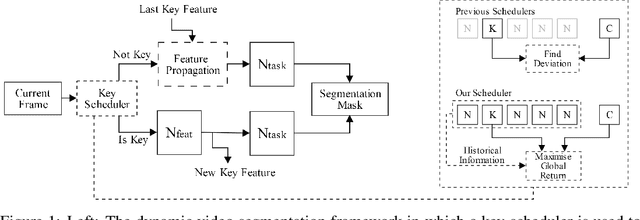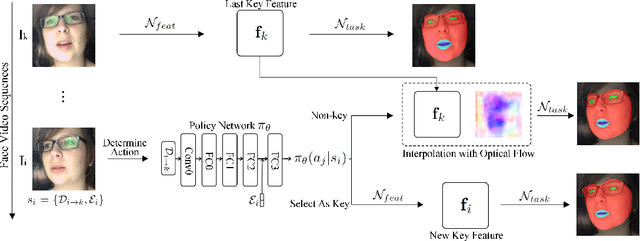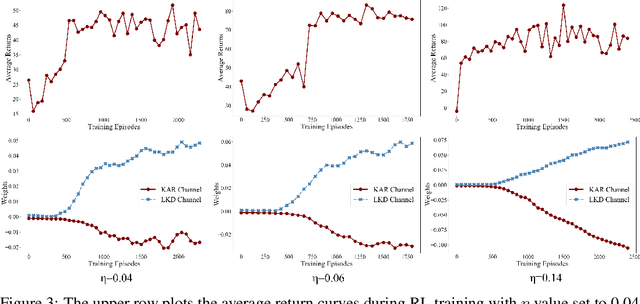Mingzhi Dong
Train Faster, Perform Better: Modular Adaptive Training in Over-Parameterized Models
May 13, 2024



Abstract:Despite their prevalence in deep-learning communities, over-parameterized models convey high demands of computational costs for proper training. This work studies the fine-grained, modular-level learning dynamics of over-parameterized models to attain a more efficient and fruitful training strategy. Empirical evidence reveals that when scaling down into network modules, such as heads in self-attention models, we can observe varying learning patterns implicitly associated with each module's trainability. To describe such modular-level learning capabilities, we introduce a novel concept dubbed modular neural tangent kernel (mNTK), and we demonstrate that the quality of a module's learning is tightly associated with its mNTK's principal eigenvalue $\lambda_{\max}$. A large $\lambda_{\max}$ indicates that the module learns features with better convergence, while those miniature ones may impact generalization negatively. Inspired by the discovery, we propose a novel training strategy termed Modular Adaptive Training (MAT) to update those modules with their $\lambda_{\max}$ exceeding a dynamic threshold selectively, concentrating the model on learning common features and ignoring those inconsistent ones. Unlike most existing training schemes with a complete BP cycle across all network modules, MAT can significantly save computations by its partially-updating strategy and can further improve performance. Experiments show that MAT nearly halves the computational cost of model training and outperforms the accuracy of baselines.
Is dataset condensation a silver bullet for healthcare data sharing?
May 05, 2023Abstract:Safeguarding personal information is paramount for healthcare data sharing, a challenging issue without any silver bullet thus far. We study the prospect of a recent deep-learning advent, dataset condensation (DC), in sharing healthcare data for AI research, and the results are promising. The condensed data abstracts original records and irreversibly conceals individual-level knowledge to achieve a bona fide de-identification, which permits free sharing. Moreover, the original deep-learning utilities are well preserved in the condensed data with compressed volume and accelerated model convergences. In PhysioNet-2012, a condensed dataset of 20 samples can orient deep models attaining 80.3% test AUC of mortality prediction (versus 85.8% of 5120 original records), an inspiring discovery generalised to MIMIC-III and Coswara datasets. We also interpret the inhere privacy protections of DC through theoretical analysis and empirical evidence. Dataset condensation opens a new gate to sharing healthcare data for AI research with multiple desirable traits.
Self-supervised Video-centralised Transformer for Video Face Clustering
Mar 24, 2022



Abstract:This paper presents a novel method for face clustering in videos using a video-centralised transformer. Previous works often employed contrastive learning to learn frame-level representation and used average pooling to aggregate the features along the temporal dimension. This approach may not fully capture the complicated video dynamics. In addition, despite the recent progress in video-based contrastive learning, few have attempted to learn a self-supervised clustering-friendly face representation that benefits the video face clustering task. To overcome these limitations, our method employs a transformer to directly learn video-level representations that can better reflect the temporally-varying property of faces in videos, while we also propose a video-centralised self-supervised framework to train the transformer model. We also investigate face clustering in egocentric videos, a fast-emerging field that has not been studied yet in works related to face clustering. To this end, we present and release the first large-scale egocentric video face clustering dataset named EasyCom-Clustering. We evaluate our proposed method on both the widely used Big Bang Theory (BBT) dataset and the new EasyCom-Clustering dataset. Results show the performance of our video-centralised transformer has surpassed all previous state-of-the-art methods on both benchmarks, exhibiting a self-attentive understanding of face videos.
Do Smart Glasses Dream of Sentimental Visions? Deep Emotionship Analysis for Eyewear Devices
Jan 24, 2022



Abstract:Emotion recognition in smart eyewear devices is highly valuable but challenging. One key limitation of previous works is that the expression-related information like facial or eye images is considered as the only emotional evidence. However, emotional status is not isolated; it is tightly associated with people's visual perceptions, especially those sentimental ones. However, little work has examined such associations to better illustrate the cause of different emotions. In this paper, we study the emotionship analysis problem in eyewear systems, an ambitious task that requires not only classifying the user's emotions but also semantically understanding the potential cause of such emotions. To this end, we devise EMOShip, a deep-learning-based eyewear system that can automatically detect the wearer's emotional status and simultaneously analyze its associations with semantic-level visual perceptions. Experimental studies with 20 participants demonstrate that, thanks to the emotionship awareness, EMOShip not only achieves superior emotion recognition accuracy over existing methods (80.2% vs. 69.4%), but also provides a valuable understanding of the cause of emotions. Pilot studies with 20 participants further motivate the potential use of EMOShip to empower emotion-aware applications, such as emotionship self-reflection and emotionship life-logging.
MemX: An Attention-Aware Smart Eyewear System for Personalized Moment Auto-capture
May 03, 2021



Abstract:This work presents MemX: a biologically-inspired attention-aware eyewear system developed with the goal of pursuing the long-awaited vision of a personalized visual Memex. MemX captures human visual attention on the fly, analyzes the salient visual content, and records moments of personal interest in the form of compact video snippets. Accurate attentive scene detection and analysis on resource-constrained platforms is challenging because these tasks are computation and energy intensive. We propose a new temporal visual attention network that unifies human visual attention tracking and salient visual content analysis. Attention tracking focuses computation-intensive video analysis on salient regions, while video analysis makes human attention detection and tracking more accurate. Using the YouTube-VIS dataset and 30 participants, we experimentally show that MemX significantly improves the attention tracking accuracy over the eye-tracking-alone method, while maintaining high system energy efficiency. We have also conducted 11 in-field pilot studies across a range of daily usage scenarios, which demonstrate the feasibility and potential benefits of MemX.
A Reinforcement-Learning-Based Energy-Efficient Framework for Multi-Task Video Analytics Pipeline
May 02, 2021



Abstract:Deep-learning-based video processing has yielded transformative results in recent years. However, the video analytics pipeline is energy-intensive due to high data rates and reliance on complex inference algorithms, which limits its adoption in energy-constrained applications. Motivated by the observation of high and variable spatial redundancy and temporal dynamics in video data streams, we design and evaluate an adaptive-resolution optimization framework to minimize the energy use of multi-task video analytics pipelines. Instead of heuristically tuning the input data resolution of individual tasks, our framework utilizes deep reinforcement learning to dynamically govern the input resolution and computation of the entire video analytics pipeline. By monitoring the impact of varying resolution on the quality of high-dimensional video analytics features, hence the accuracy of video analytics results, the proposed end-to-end optimization framework learns the best non-myopic policy for dynamically controlling the resolution of input video streams to globally optimize energy efficiency. Governed by reinforcement learning, optical flow is incorporated into the framework to minimize unnecessary spatio-temporal redundancy that leads to re-computation, while preserving accuracy. The proposed framework is applied to video instance segmentation which is one of the most challenging computer vision tasks, and achieves better energy efficiency than all baseline methods of similar accuracy on the YouTube-VIS dataset.
Dilated Convolutions with Lateral Inhibitions for Semantic Image Segmentation
Jun 16, 2020



Abstract:Dilated convolutions are widely used in deep semantic segmentation models as they can enlarge the filters' receptive field without adding additional weights nor sacrificing spatial resolution. However, as dilated convolutional filters do not possess positional knowledge about the pixels on semantically meaningful contours, they could lead to ambiguous predictions on object boundaries. In addition, although dilating the filter can expand its receptive field, the total number of sampled pixels remains unchanged, which usually comprises a small fraction of the receptive field's total area. Inspired by the Lateral Inhibition (LI) mechanisms in human visual systems, we propose the dilated convolution with lateral inhibitions (LI-Convs) to overcome these limitations. Introducing LI mechanisms improves the convolutional filter's sensitivity to semantic object boundaries. Moreover, since LI-Convs also implicitly take the pixels from the laterally inhibited zones into consideration, they can also extract features at a denser scale. By integrating LI-Convs into the Deeplabv3+ architecture, we propose the Lateral Inhibited Atrous Spatial Pyramid Pooling (LI-ASPP) and the Lateral Inhibited MobileNet-V2 (LI-MNV2). Experimental results on three benchmark datasets (PASCAL VOC 2012, CelebAMask-HQ and ADE20K) show that our LI-based segmentation models outperform the baseline on all of them, thus verify the effectiveness and generality of the proposed LI-Convs.
Towards Certified Robustness of Metric Learning
Jun 10, 2020



Abstract:Metric learning aims to learn a distance metric such that semantically similar instances are pulled together while dissimilar instances are pushed away. Many existing methods consider maximizing or at least constraining a distance "margin" that separates similar and dissimilar pairs of instances to guarantee their performance on a subsequent k-nearest neighbor classifier. However, such a margin in the feature space does not necessarily lead to robustness certification or even anticipated generalization advantage, since a small perturbation of test instance in the instance space could still potentially alter the model prediction. To address this problem, we advocate penalizing small distance between training instances and their nearest adversarial examples, and we show that the resulting new approach to metric learning enjoys a larger certified neighborhood with theoretical performance guarantee. Moreover, drawing on an intuitive geometric insight, the proposed new loss term permits an analytically elegant closed-form solution and offers great flexibility in leveraging it jointly with existing metric learning methods. Extensive experiments demonstrate the superiority of the proposed method over the state-of-the-arts in terms of both discrimination accuracy and robustness to noise.
Dynamic Face Video Segmentation via Reinforcement Learning
Jul 02, 2019



Abstract:For real-time semantic video segmentation, most recent works utilise a dynamic framework with a key scheduler to make online key/non-key decisions. Some works used a fixed key scheduling policy, while others proposed adaptive key scheduling methods based on heuristic strategies, both of which may lead to suboptimal global performance. To overcome this limitation, we propose to model the online key decision process in dynamic video segmentation as a deep reinforcement learning problem, and to learn an efficient and effective scheduling policy from expert information about decision history and from the process of maximising global return. Moreover, we study the application of dynamic video segmentation on face videos, a field that has not been investigated before. By evaluating on the 300VW dataset, we show that the performance of our reinforcement key scheduler outperforms that of various baseline approaches, and our method could also achieve real-time processing speed. To the best of our knowledge, this is the first work to use reinforcement learning for online key-frame decision in dynamic video segmentation, and also the first work on its application on face videos.
Dynamic Ensemble Active Learning: A Non-Stationary Bandit with Expert Advice
Sep 29, 2018



Abstract:Active learning aims to reduce annotation cost by predicting which samples are useful for a human teacher to label. However it has become clear there is no best active learning algorithm. Inspired by various philosophies about what constitutes a good criteria, different algorithms perform well on different datasets. This has motivated research into ensembles of active learners that learn what constitutes a good criteria in a given scenario, typically via multi-armed bandit algorithms. Though algorithm ensembles can lead to better results, they overlook the fact that not only does algorithm efficacy vary across datasets, but also during a single active learning session. That is, the best criteria is non-stationary. This breaks existing algorithms' guarantees and hampers their performance in practice. In this paper, we propose dynamic ensemble active learning as a more general and promising research direction. We develop a dynamic ensemble active learner based on a non-stationary multi-armed bandit with expert advice algorithm. Our dynamic ensemble selects the right criteria at each step of active learning. It has theoretical guarantees, and shows encouraging results on $13$ popular datasets.
 Add to Chrome
Add to Chrome Add to Firefox
Add to Firefox Add to Edge
Add to Edge